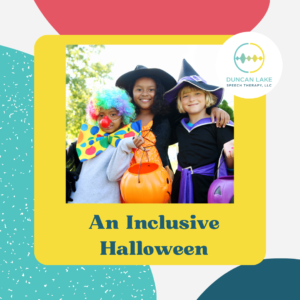by Tamiko Teshima, M.A, CCC-SLP
Practice Owner and Speech-Language Pathologist
Duncan Lake Speech Therapy, LLC
Note: Tami here! This is an updated version of our very popular post from 2019. I do need to go through and update our educational resources, but otherwise, this is just a little refresh. Happy Halloween, all!
At Duncan Lake Speech Therapy, inclusion and accessibility are at the heart of everything we do. According to Kids Together, Inc., inclusion means “being a part of what everyone else is, being welcomed and embraced as a member who belongs.” True inclusion ensures that everyone, regardless of ability, disability, religion, culture, ethnicity, sexuality, gender, or race, feels like they belong.
While inclusive practices are gaining more attention, there are still many everyday activities that exclude certain groups of people—Halloween is no exception. For many, it’s one of the most fun-filled, candy-packed holidays of the year, but it can pose challenges for children with disabilities.
Let’s talk about how we can make Halloween a more inclusive and enjoyable experience for every child this year.
Step 1: Education is Key
The first step to creating inclusive spaces is learning about different disabilities. By educating ourselves, we become more aware of the barriers that exist and how we can reduce them. We’ve put together a blog post with resources to help you get started—check it out to deepen your understanding!
Step 2: Offering Inclusive Treats
One simple way to promote inclusivity is by offering non-food treats. Many children have dietary restrictions, ranging from food allergies and diabetes to sensory aversions. Offering items like slime, glow bracelets, bubbles, or stickers ensures that every trick-or-treater can enjoy the experience, regardless of their dietary needs.
Step 3: Reimagining “Trick-or-Treat”
Traditionally, children are expected to say “trick-or-treat” when they arrive at your door. But for many kids, this can be challenging—some may be non-verbal, while others may struggle with social skills or have cognitive difficulties. Instead of requiring children to say the phrase, consider alternative communication methods, such as using a core board or a fun pre-recorded button with “trick-or-treat” already programmed in. You can also say “trick-or-treat” to them as a way to model the interaction.
Above all, please don’t withhold candy if a child doesn’t say “trick-or-treat.” Inclusion means understanding that communication looks different for everyone.
Step 4: Be Mindful of Sensory Sensitivities
Halloween can be overwhelming for children with sensory sensitivities due to bright lights, loud sounds, and elaborate decorations. Flashing lights, smoke machines, and loud noises can be particularly difficult for children with sensitivities to light and sound. Consider creating a quieter, sensory-friendly environment by minimizing loud sounds and intense lights. A simple, inviting setup can still be festive without causing sensory overload.
Step 5: Consider Accessibility for All
Think about how children will access your Halloween setup. If your home has stairs, it might be challenging for children who use wheelchairs or walkers. Similarly, some children may have limited mobility, making it hard for them to reach candy bowls. If you can, create an alternate way for children with physical limitations to access treats—whether that’s by greeting them at the end of your driveway or offering treats at a lower level. Also, ensure there is enough lighting for children with low vision to navigate safely.
By making these thoughtful adjustments, you can help make Halloween a more inclusive experience for everyone. Inclusion starts with small changes, but it can make a world of difference for the children in our community. Let’s make this Halloween one to remember—for all the right reasons!




Recent Comments